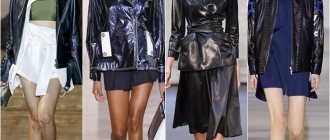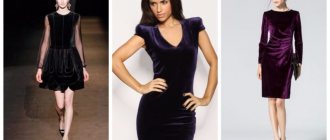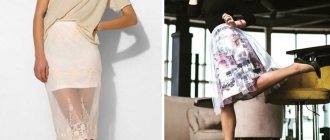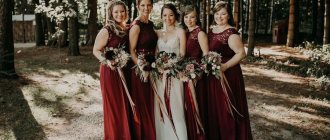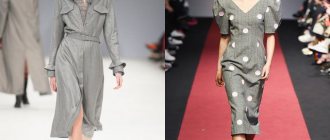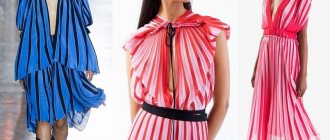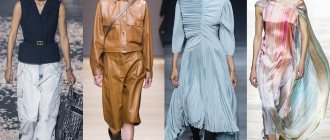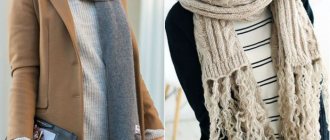Dictionary of fashion terms
Fashion constantly creates new terms and forgets old ones. Every season, new items that come into fashion make us remember some words and consign others to oblivion. Names such as “hairatnik” or “dolchiki” today can cause bewilderment among young ladies and nostalgia among those who still remember what they mean. To be sure of the names of certain forms of clothing, refer to our brief dictionary of fashion terms.English costume
Initially exclusively a men's suit, considered a traditional, conservative, sustainable set of clothing suitable for working in a business environment, in the office. It originally arose in England in a bourgeois environment at the end of the 18th - beginning of the 19th centuries. Consists of a jacket, trousers and vest. Complete with a formal shirt, tie and shoes. Made from worsted (suit) fabrics of dark color (dark blue, dark gray). The English suit entered women's clothing at the end of the 19th century. (See “A Brief History of the Business Suit”) Initially it consisted of a straight skirt and a jacket-type jacket (lined with a turn-down collar and lapels). Fabrics in stripes, checks and plain, soothing colors were used for it. The English suit is a fashion classic of the 20th century. Once it appears, it does not lose its relevance, but its proportions, silhouette, shape of pockets, collar and lapels change periodically.
Blazer
(English Blazer) Club jacket. Classic cut jacket, single or double breasted. The main feature of a blazer is metal buttons - enameled or with the image of the owner's coat of arms, club emblem or naval symbols. Other distinctive features include a patch chest pocket with an embroidered club badge or crest and contrast piping throughout. Legend attributes the invention of the blazer to the captain of the royal frigate Blazer. On the occasion of Queen Victoria's visit in 1837, he dressed the ship's crew in dark blue, double-breasted jackets with six large gilt buttons. The new uniform was approved by Her Majesty and quickly spread to other ships. Since the 19th century the blazer became the uniform of English rowing clubs. In the 20th century It became part of the uniform in English girls' schools. Since the 1920s became widespread in women's wardrobes, and has regularly come into fashion for over a century. The color of the blazer is usually dark blue, although blazers of other colors are also available. According to the rules, it is combined with trousers of a lighter shade - white, cream. The women's version may have a skirt instead of trousers, but also in a much lighter color.
Blouse
(French Blouse) Women's shoulder-length outer clothing, hip-length, with long or short sleeves. It can be hinged or have a short clasp. There are also options without clasp. Its origins date back to the 1880s, when ladies complemented their wardrobe with a men's shirt. Women's blouses became an independent type of clothing, and very elegant versions appeared, trimmed with lace and embroidery, which became the actual “blouse,” although the name was fixed later. They were worn paired with a long skirt or as part of a suit. An English blouse (with a high stand-up collar) made of cotton, linen, and silk was also called Victorian. Blouses with a slanted collar in Europe were called Russian. Blouses are made from thin materials - cambric, chiffon, crepe de Chine, charmeuse satin and thin jersey (knitted fabric). The blouse is an integral element of a classic women's suit. Today there are shirt blouses (reminiscent of men's business shirts), blouses themselves (differing in more femininity, soft fabrics and designs, neckline) and tops - open blouses without sleeves, with straps or bustiers.
Bolero
(Spanish: Bolero) A short jacket that extends above the waistline, usually without a fastener, often with rounded edges. Originally - the jacket of a Spanish bullfighter. It is sewn from a variety of fabrics, knitwear or woven from lace. Often serves as an addition to a dress with an open top.
Breeches
(English Breeches - wide short pants) Loose trousers just below the knee, usually with cuffs. They tightly cover the calves of the legs below the knee, and are made quite wide at the hips. Initially used for sports and hunting, they were made from woolen checkered fabrics or tweed.
Trousers
(borrowed from Low German Brok or Goll. Broec - pants; the word came into use during the reign of Peter I) Belt clothing covering the legs, each separately. Trousers are of Eastern origin and were originally worn by nomadic peoples for horse riding. In its ancient form, the dhoti (a piece of cloth wrapped in a special way around the legs) is still in use in India and Pakistan. In Europe, trousers underwent a long evolution and were known under different names - pantaloons, culottes, breeches, etc. Since the 12th century, trousers have been considered exclusively men's clothing and are strictly prohibited for women. For the first time, women's bloomers trousers (named after Amalia Bloomer, who herself wore them and popularized them in her magazine) - a type of bloomers - appeared in the middle of the 19th century, and by the end of the century they were widely used for cycling, but were still condemned by the public. The turning point occurred during the First World War, when women, who replaced men in many jobs, began to wear men's clothing, including trousers. From this moment on, women's trousers are actively spreading in Europe and America, but for now they are classified as clothing for sports and leisure, remaining prohibited in the urban environment. The legalization of urban women's trousers, as well as the women's trouser suit for the office, occurred thanks to Yves Saint Laurent in the late 1960s. Modern classic women's trousers have two front and two back panels connected by seams, as well as a front or side fastener. These trousers are cut from suit fabrics, straight or slightly tapered, and have pressed creases. Classic trousers are also often equipped with tucks at the waist and cuffs at the bottom of the legs. Along with classic business trousers, modern fashion has a wide range of other forms of trousers, many of which have their own designation - capris, breeches, cargo, etc.
Bustier
(French Buste, English Bustier) A blouse-top or dress with an open top and strapless. Usually it fits tightly to the figure and can even be based on a corset. As a piece of underwear, the bustier has been known in various forms since the beginning of the 19th century. Popular in the 1950s, the bustier came back into fashion in the 1980s as evening wear. Since that time, it has become possible to wear a bustier with a suit, under a jacket, or on its own. Today, bustier dresses are common, especially elegant ones, for special occasions.
Evening Dress
Full length formal dress. Along with the floor length in the 1950s. A “ballet-length” dress came into fashion - up to ankle level. Evening dresses are made from elegant fabrics - satin, velvet, lace - and decorated with rhinestones, feathers, embroidery, applique, etc. According to the rules, elegant high-heeled shoes, a clutch handbag, high gloves and jewelry with natural stones are required for an evening dress, but today these rules can often be neglected.
Business suit
Symbol for a men's or women's classic suit for office work. In the Euro-American tradition, there are strict rules and restrictions dictated by business etiquette and regarding the shape, color of the suit and accessories and their combinations (See the section “Dress codes and whether they must be observed”). A women's business suit consists of a jacket, skirt and shirt-type blouse. The pantsuit for women working in an office is an acceptable alternative, legalized by Yves Saint Laurent in the late 1960s. A women's business suit can be blue and gray, beige and sand colors are allowed. The blouse should be light, preferably without a pattern. At the end of the 1990s. There has been a trend towards democratization of the business suit. It has become possible to deviate from the blue-gray palette, especially in women's clothing, where all light, pastel colors and some bright colors are allowed. In some cases, you can replace the shirt with a blouse or knitted jumper or pullover. For office work, black or brown shoes with moderate heels are recommended.
Jacket
(English Jacket) Predominantly women's outerwear with sleeves and length ending from the waist to the middle of the hips. The same as a jacket in men's clothing. There are many options. Types of jackets - cardigan, tuxedo, blazer, etc. Today, jacket is the most general designation for various types of men's and women's clothing.
Jacket-coat
Jacket made of coat fabric. A type of elegant urban outerwear. Can be combined with a skirt made of the same fabric (in this case we can talk about a coat suit
Safari jacket
A jacket made of linen or cotton fabric with four patch pockets with flaps, a belt with a buckle, and often with shoulder straps. A safari jacket usually has a stand-up collar or, less commonly, an English collar. Initially, the safari jacket was used by the British military in the colonies, and therefore has a characteristic shade of beige and sand. At the end of the 1960s. The fashion for safari style was initiated by Yves Saint Laurent. This jacket is usually combined with a straight skirt, trousers or shorts. Sometimes there are safari dresses, which are an elongated version of the jacket. Today, the safari jacket and safari style are a classic in an elegant women's summer wardrobe.
Vest
(French Gilet) Outer swing shoulder garment without sleeves or collar. Originally, it was a type of men's clothing worn under a camisole over a shirt. Along with the tie, the vest for a long time remained the only bright detail of the men's toilet; only its color and, to a small extent, style changed. At the end of the 19th century. women have made the vest part of their wardrobe. In the 1960s The vest has become part of the modern informal wardrobe. Various versions of it were created, some of which were borrowed from the East and Africa.
Capri
(based on the island of Capri in Italy) Tight-fitting narrow or straight women's trousers, just below the knee or mid-calf length, which came into fashion in the 1950s. Sometimes capris are equipped with small slits at the bottom of the side seams. According to legend, the invention of Capri pants is attributed to Emilio Pucci, an Italian designer who had a factory on the island of Capri where they were produced. In addition, Capri in those years became a popular resort, where such trousers were actively worn, for example, by American tourists.
Cocktail Dress
Or a cocktail dress. Elegant knee-length dress of any design. It differs from evening wear not only in length, but also in less expensive fabrics and more modest decoration. The cocktail dress came into fashion in the 1920s, during Prohibition and the Jazz Age. Young women wanted to look smart, but less formal and more dynamic. Such a dress was then complemented by a fur boa or coat, which made up an ensemble with it. Today, a cocktail dress can be complemented with a jacket (for example, a bolero) or a stole.
Little black dress
A popular form of formal sheath dress, as well as cocktail dresses. Legend credits its invention to Gabrielle (Coco) Chanel in 1926, but many designers developed similar designs almost simultaneously after World War I, when black transitioned from a funereal color to an everyday color. For example, Jeanne Lanvin created such dresses back during the war, and Chanel herself began using black in dresses already in 1919. Throughout the twentieth century. The dress has undergone a number of changes, becoming a symbol of feminine elegance. The classic shape of the little black dress is a simple, body-hugging, knee-length dress with long sleeves. Business and cocktail forms of a little black dress can be sleeveless and even with straps. The material of the little black dress can be anything, but its black color remains unchanged.
Blazer
(English Pea-jacket) Men's shoulder swing clothing, a jacket of a semi-fitting or straight silhouette, with long sleeves and an English collar, button closure and pockets (usually welt). Often one or two vents are made on the back of the jacket, and the waist is cut with cut-off barrels. The jacket serves as the basis for many forms of men's and women's jackets - blazer, tuxedo, etc. The word “jacket” in the Russian colloquial tradition is also applied to women’s jackets of the blazer type.
Dress
A form of women's clothing that covers the entire torso and legs, sometimes down to the floor. The dress can be cut at the waist (in this case it consists of a bodice and skirt sewn together) and one-piece; with sleeves of any length or without them (a dress with an open top without straps is called a bustier dress), with any other details. Along with open dress forms, there are dresses-robes, dresses-shirts, dresses-aprons, dresses-coats. A dress with an open top and straps is called a sundress in Russian colloquial tradition. Presumably the dress originated from the tunic of ancient times and the simplest undershirts of the early Middle Ages. According to another version, it comes from Asian clothing such as a caftan. In Europe, the first women's dresses resembling modern ones appeared around the 12th century, when the development of intricately tailored clothing began. Throughout history, the dress has taken on various forms. In the 20th century, dresses were divided according to functionality - wedding, elegant, cocktail, casual, business, etc. Many dresses have enduring names, for example, little black dress, princess dress, etc.
Coat dress
An elegant swing dress with a through fastener from top to bottom, reminiscent of a city coat in design. It differs from a coat in lighter (dress, suit) fabrics. The coat dress was very popular in the 1950s and today can be used as office wear.
Princess dress
A stable designation for a dress with an hourglass silhouette - with a very narrow bodice and a full skirt. It became most widespread in the late 1940s and early 1950s. and is associated with the new look style of Christian Dior.
Dress shirt
A dress with sleeves and a fastening to the waist, often with a belt. This cut has been known since the 1920s, when Gabrielle Chanel's little black dress was cut this way. A dress with buttons from top to bottom, reminiscent of a men's shirt, came into fashion in the 1960s.
Apron dress
A swing dress with a large wrap around the back that wraps around the figure. May look like a sundress.
Sheath dress
A narrow dress with a fitted or semi-fitted silhouette. Often sleeveless and with a small neckline, usually the so-called classic length - to knee level. Often used as a business dress, which can be worn with a jacket instead of a skirt. Sometimes a sheath dress is complemented by a blouse or jumper that is worn underneath it.
Swinger
(English Swinger) A jacket or jacket-coat of a trapezoidal silhouette with a strong flare down the back. The length of the swinger varies from the waist to the hips and even below.
Top
(English Top - top, upper part) Designation of any short (to the waist) piece of light women's clothing. In a narrow sense - a tight-fitting T-shirt with or without straps.
Trench coat, trench coat
(English Trench coat - “trench coat”) A military raincoat, which was originally produced by the English companies Burberry and Aquascutum from specially developed gabardine fabric. Trench coat is a straight double-breasted coat with an English collar that can be buttoned under the neck; with a flying yoke and shoulder straps; welt pockets and a belt with a buckle. There is usually a slot at the back. The trench coat first came into widespread use during the First World War, when women first began to wear it. It was very popular in the 1930s and 1940s thanks to film stars such as Greta Garbo and Humphrey Bogart, who often appeared wearing the trench coat on camera and in real life. The trench coat was given a second life by Yves Saint Laurent, who introduced it into fashion in the late 1960s. Today, the trench coat is considered a must-have item and has become a classic of elegant women's clothing.
Tunic
(Latin: Tunica) A straight shirt or dress, mid-thigh or knee-length, usually without a collar and with slits on the sides. Worn as an independent type of clothing or in a set with a skirt or trousers. Goes back to ancient Greek and Roman clothing.
Skirt
(Polish jupa from German Jope, Jupe and French jupe - skirt) Belt women's clothing, covering from the waist to the bottom of various lengths, as well as part of a woman's dress, cut off along the waist line. The skirt is one of the most ancient types of clothing, both men's and women's. Skirts can be straight, tapered or flared. The skirt can be cut from 2, 4, 6, 8 or more fabrics. A special case is the circle skirt (cut in the shape of a circle with a hole in the center for the waist) or the circle skirt (cut from a segment of a circle). Some types of skirts have stable names.
Skirt year
(French Godet) A skirt that fits tightly at the waist and hips and widens downwards from the middle of the thigh or from the knee. Usually cut with wedges or with wedge-shaped inserts
Pencil skirt
Knee-length tapered skirt. Can be part of an office suit. For ease of movement, it is usually equipped with a slot or cut.
Straight skirt
A narrow skirt that falls from the hips perpendicular to the floor, usually knee-length or higher. A straight classic skirt with a vent is part of a women's business suit.
Tulip skirt
The skirt flares out from the waistline, is full at the hips and tapered at the bottom. Typically knee length or higher. The fullness in the hips can be provided by gathers, pleats or tucks. Sometimes it is cut with a wrap. Top
Stylish short jacket models spring 2020 - current trends, photos
Women's jackets for the spring 2020 season are intended for those girls and women who, when composing their looks, give preference to comfort, but at the same time want to stay on trend. Oversize clothing has long been one of the most favorite products among fashionistas. They look most advantageous on petite girls and women, because they once again emphasize the grace of their owner’s figure.
Cropped, fitted jackets resemble blazers and cardigans. With the arrival of spring, such models are used by fashionistas to create stylish looks in combination with skirts, trousers and jeans. Stylists recommend these styles to be worn by those with a slender figure; girls with more voluminous body proportions are more suitable for loose-fitting models up to mid-thigh or slightly lower.
